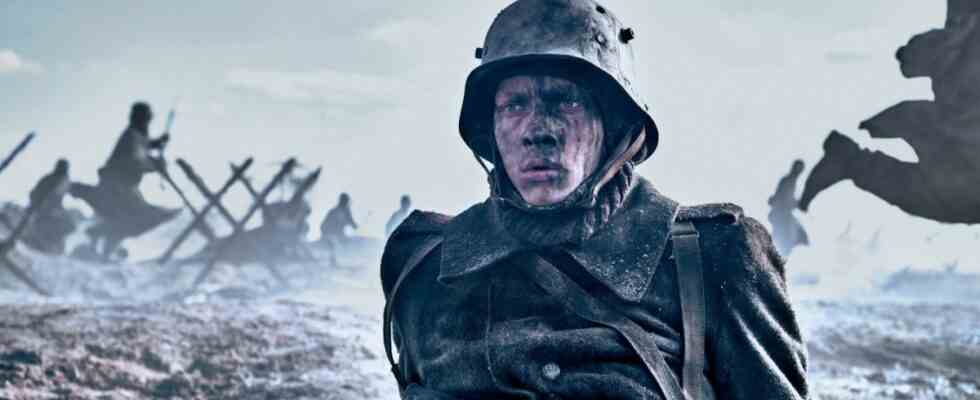Erich Paul Remark was at the front in Flanders for only a few weeks, as a young recruit in July 1917. He was then wounded and spent the rest of World War I in a military hospital in Germany. But one of the most important books ever written in German came out of this short time during the war: in 1929, the former soldier published the novel “Nothing New in the West” under the name Erich Maria Remarque, a narrow volume only, but with enormous impact .
In it, Remarque described the war on the western front as it had been – apocalyptic madness. “Nothing New in the West” became a worldwide bestseller, a classic of war and anti-war literature, a monument printed on paper against the idea that the greatness of a nation depends on its young men killing the young men of the neighboring country. The first film adaptation won two Oscars in 1930.
These are actually the best prerequisites for doing something sensible with the novel. However, with its new film adaptation of “Nothing New in the West”, which has been running since Friday, the Netflix streaming service confirms what is perhaps the oldest prejudice of all cultural pessimists: no book is so good that it cannot be made into a bad film.
One wonders whether the director actually read the novel
Although – that’s not entirely true. The German director Edward Berger, his team and the actors have made a very impressive war film, possibly even an anti-war film. If you don’t know yet, but want to know, you can watch “Nothing New in the West” to learn that there were many ways of killing and dying in the First World War. The soldiers were torn apart by shells, riddled with bullets, suffocated by poison gas, buried by collapsing bunker ceilings, crushed by tank tracks, stabbed with knives and bayonets by their opponents, beaten with spades, burned with flamethrowers. The film shows all of this with realistic brutality.
He also shows the miserable life in the trenches. The constant rain turns the battle-ravaged plains of northern France into morass. The soldiers crouch frightened in burrows, they crawl through mud, they wade through mud, they fall into shell craters filled with water that is brown – or red with blood. Corpses hang in the barbed wire in front of the trenches, armies of rats run through the shelters. According to everything that has been handed down about the conditions on the western front, the picture painted by Berger’s film comes very close to reality. That’s an achievement.
Unfortunately, the film “Nothing New in the West” only comes close to the book “Nothing New in the West” in a very fleeting way. During the almost two and a half hours that the film lasts, one wonders at times whether director Berger has even read Remarque’s novel. Or, if so, whether he only read it to discard as much original material as possible so that he and his screenwriters could invent as much new material as possible. In any case, as a rough estimate, eight or more tenths of the film consists of scenes that have not only little to do with the book, but nothing at all. If the characters in the film didn’t have the same names as in the book – Paul Bäumer, Albert Kropp, Kat – then it would be difficult to find any significant parallels between the two works.
Berger adds characters to the novel in his film at will, for example the politician Matthias Erzberger played by Daniel Brühl. The director invents all sorts of new storylines, while at the same time omitting or shortening other characters and scenes that are central to the novel and changing them so drastically that they seem as if he has a quick best-of-remarque at the end of filming – want to process the list. The agonizing days that the young German soldier Bäumer spends in the novel in a shell hole next to a slowly dying Frenchman whom he has stabbed shrink to a few inconsequential minutes in Berger’s work – a few images of horror among many.
In the film, Berger credits the soldier Kat, a protector and father figure for the lost recruit Bäumer, with a ten-year-old son who died of smallpox. Why? Who knows. Perhaps as a dramaturgical connection to the later scene, which was also invented, in which Kat is shot by a ten-year-old French farm boy while she is stealing eggs.
Berger even rewrote the short epilogue, which gave the novel its laconic title in 1929. In Remarque, Paul Bäumer falls almost casually a few weeks before the end of the war – on a day “that was so calm and quiet along the entire front that the army report was limited to the sentence that there was nothing new to report in the West”. In Berger’s film, on the other hand, Bäumer’s death is the climax of a final, dramatic assault slaughter. A few seconds before the armistice, he is pierced by a bayonet. Berger cuts the not unimportant connection between content and title without further ado. If an American director had cut through Remarque’s book in order to make it into a film, the outcry from the German arts industry would probably be tremendous.
Of course, if Remarque doesn’t have enough pacing and action, Edward Berger has every right to cram whatever he can think of about World War I into his script. Berger had to convince Netflix of the project, find financiers, he wants to be successful internationally and win awards – it’s all legitimate.
But the fact that he seriously sells his largely self-written film as an adaptation of “Nothing New in the West” is quite courageous. And it arouses the suspicion that this is all about clever marketing: two and a half hours of blockbuster war kitsch are given a title that is known worldwide, which guarantees prestige and good sales. Maybe even an Oscar.

